Over-the-Side Immersion Heater
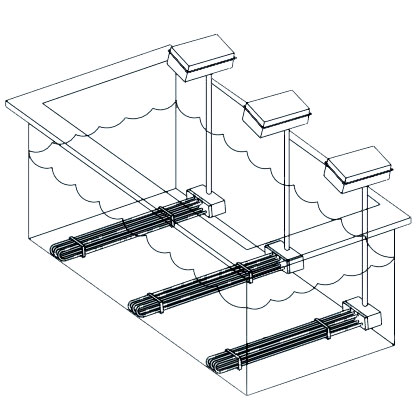
Over-the-side immersion heaters are designed for vessels where through the side submersible heaters cannot be conveniently installed.
The best way to use these heaters is installing those through the top of the vessel with the heated portion of the unit along the side or at the bottom of the tank.
Natural circulation of the fluid inside the tank allows for even distribution. Terminal houses or lead wires are provided for power connection.
The immersion heater element is installed in the top
of a tank with the heated portion
directly immersed along the side or
at the bottom. This provides easy
removal of the heater and ample
working space inside the tank.
These heaters are available with heating elements made of copper, steel, stainless steel, cast iron, Incoloy, titanium, and PFA coated. A wide
selection of kilowatt ratings, shapes and mounting methods are available to suit many different types of applications.
The large variation in inmmersion heating element material and shapes of over-the-side immersion heaters offers a wide selection in the application of these
units. Water, oils, solvent, plating baths, salts and acids are some of the many liquids and viscous materials commonly heated with immersion
heaters. Over-the-side types permit portability, easy removal for cleaning of tanks and heaters, and ample working area within the tank when installed.
Flanged Immersion Heaters
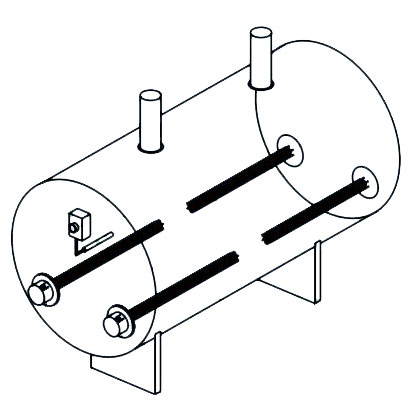
Flanged immersion heaters consist of hairpin bent tubular elements welded or brazed into a flange and provided with wiring boxes for electrical
connections. Flange heaters are installed by bolting to a matching flange welded to the tank wall or nozzle. A wide selection of flange sizes,
wattages, voltages, terminal housings and sheath materials makes these heaters ideal for all types of heating applications.
Flanged immersion heaters are one of the most widely used methods for heating liquids (such as water, oil, heat transfer fluid and corrosive
solutions). Designed for use in tanks and pressurized vessels, they are easy to install and maintain to provide heat for many processes. The
direct immersion method is energy efficient and easily monitored and controlled.
A thermostat protective well is
standard on most models. This well
is installed through the flange
parallel with the heating elements
This 1/2" thermowell is provided for
accepting a temperature sensing
probe for use with a thermostat
or other type control
system.
Flexibility of the type of control
can be provided to give exact process
control precision to match your
process needs.
These electric immersion heaters utilize standard pipe flanges ranging from 3" to 14" in diameter to support high tank pressures of
liquids. They are installed through a matching companion flange, obtainable from local industrial supply houses, to the tank wall. A wide
selection of watt densities, heating outputs and flange sizes and ratings make this an excellent heater for all tanks, vats or irregularly
shaped vessels.
Threaded or Screw Plug Immersion Heaters
Screw plug immersion heaters consist of hairpin bent tubular elements brazed or welded into a screw plug and provided with wiring boxes
for electrical connections. Screw plug immersion heaters are screwed directly through a threaded opening in a tank wall or through matching
pipe coupling, half coupling or welding flange. Sizes of screw plug heaters are available with ½", ¾", 1", 1¼", 2" and 2½" pipe threads. A
wide selection of screw plug sizes, kilowatt ratings, voltages, sheath materials, terminal housings, and thermostats makes these compact
heaters ideal for all types of applications.
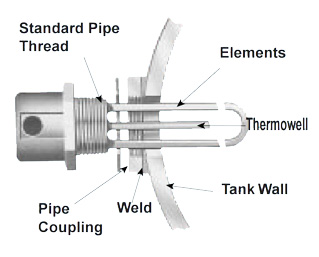
This type of electric immersion heaters are used for heating liquids in a variety of processes. Those heaters are ideal for process water heating
and freeze protection. All types of oils and heat transfer solutions can also be heated using these compact easily controlled units. The
direct immersion method is energy efficient and well suited for many applications.
The heavy duty tubular
elements are welded or brazed to a
screw plug. Uniform heat
distribution and repressed element
bends provide long element life.For
heaters with built-in thermostats, a
thermowell (hollow tube sealed at
one end) is welded or brazed to the
screw plug and allows thermostat
sensing element replacement
without draining the tank.
Screw plug heaters are equipped
with a steel enclosure, and are also
available with a combination
moisture resistant/explosion
resistant enclosure.
The heater element is screwed directly through a threaded
opening in tank wall. Heavy tank
walls may be drilled and tapped if
thickness is sufficient to engage 3/4 of
threads. Lighter tank walls should
be equipped with suitable pipe halfcoupling
attached with proper braze
or weld material.
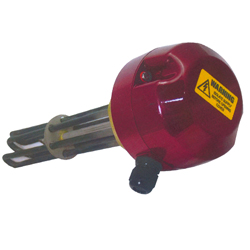
Thermostats or Temperature Control
Many screw plug and flanged type heaters are available with built-in thermostatic controls. In some installations, where there is more than one
heater in a tank, you may consider one heater with a built-in control that will control the other heaters by wiring thermostat into the holding
coil circuit of a magnetic contactor.
If the thermostat is separate from the heater, the thermostat sensing element should be located approximately
4 to 6 inches above the heater.
Other
types of controls are available where a high degree of accuracy or a more versatile control scheme is required.
Electronic controls and complete control panels are easily installed.
 CLOSE
CLOSE

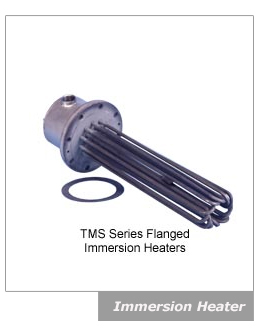
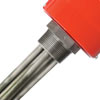
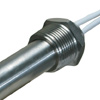

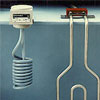
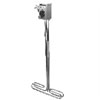




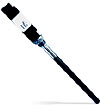
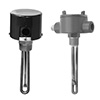
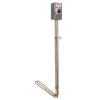
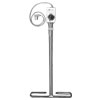
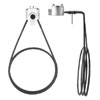
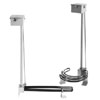

 Aquecedores de Imersão
Aquecedores de Imersão Éléments Chauffants à Immersion
Éléments Chauffants à Immersion Immersion Heaters
Immersion Heaters Thermoplongeur
Thermoplongeur Tauchheizkörpern
Tauchheizkörpern Immersion Heater
Immersion Heater Immersion Heater
Immersion Heater Immersion Heaters
Immersion Heaters 浸入式加热器
浸入式加热器 Immersion Heaters
Immersion Heaters
 투입 히터
투입 히터 Immersion Heaters
Immersion Heaters
 Immersion Heaters
Immersion Heaters
 Immersion Heaters
Immersion Heaters
 Immersion Heaters
Immersion Heaters
 Immersion Heaters
Immersion Heaters